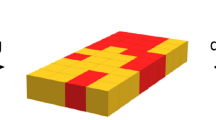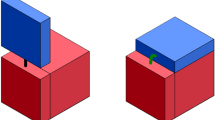Abstract
In this paper, we investigate the abilities of systems of self-assembling tiles which can each pass a constant number of signals to their immediate neighbors to create replicas of input shapes. Namely, we work within the Signal-passing Tile Assembly Model (STAM), and we provide a universal STAM tile set which is capable of creating unbounded numbers of assemblies of shapes identical to those of input assemblies. The shapes of the input assemblies can be arbitrary 2-dimensional hole-free shapes. This improves previous shape replication results in self-assembly that required models in which multiple assembly stages and/or bins were required, and the shapes which could be replicated were more constrained, as well as a previous version of this result that required input shapes to be represented at scale factor 2.









































Similar content being viewed by others
References
Abel, Z., Benbernou, N., Damian, M., Demaine, E., Demaine, M., Flatland, R., Kominers, S., Schweller, R.: Shape replication through self-assembly and RNase enzymes. In: SODA 2010: Proceedings of the Twenty-first Annual ACM-SIAM Symposium on Discrete Algorithms (Austin, Texas), Society for Industrial and Applied Mathematics (2010)
Alseth, A., Hader, D., Patitz, M.J.: Self-replication via tile self-assembly (extended abstract). In: 27th International Conference on DNA Computing and Molecular Programming (DNA 27) (Dagstuhl, Germany) (Lakin, Matthew R., Petr Šulc, eds.), Leibniz International Proceedings in Informatics (LIPIcs), vol. 205, Schloss Dagstuhl – Leibniz-Zentrum für Informatik, pp. 3:1–3:22 (2021)
Barish, R.D., Schulman, R., Rothemund, P.W., Winfree, E.: An information-bearing seed for nucleating algorithmic self-assembly. Proc. Natl. Acad. Sci. 106(15), 6054–6059 (2009)
Chalk, C., Demaine, E.D., Demaine, M.L., Martinez, E., Schweller, R., Vega, Luis, W.T.: Universal shape replicators via Self-Assembly with Attractive and Repulsive Forces. In: Proceedings of the Twenty-Eighth Annual ACM-SIAM Symposium on Discrete Algorithms, Society for Industrial and Applied Mathematics, January, pp. 225–238 (2017)
Cheng, Q., Aggarwal, G., Goldwasser, M.H., Kao, M.-Y., Schweller, R.T.: and Pablo Moisset de Espanés, Complexities for generalized models of self-assembly. SIAM J. Comput. 34, 1493–1515 (2005)
Demaine, E.D., Demaine, M.L., Fekete, S.P., Ishaque, M., Rafalin, E., Schweller, Robert T., Souvaine, Diane L.: Staged self-assembly: nanomanufacture of arbitrary shapes with \({O}(1)\) glues. Natl. Comput. 7(3), 347–370 (2008)
Doty, D., Lutz, J.H., Patitz, M.J., Schweller, R.T., Summers, S.M., Woods, D.: The tile assembly model is intrinsically universal. In: Proceedings of the 53rd Annual IEEE Symposium on Foundations of Computer Science, FOCS 2012, pp. 302–310 (2012)
Evans, C.G.: Crystals that count! Physical principles and experimental investigations of DNA tile self-assembly. Ph.D. thesis, California Institute of Technology (2014)
Fochtman, T., Hendricks, J., Padilla, J.E., Patitz, M.J., Rogers, T.A.: Signal transmission across tile assemblies: 3d static tiles simulate active self-assembly by 2d signal-passing tiles. Natl. Comput. 14(2), 251–264 (2015)
Keenan, A., Schweller, R.T., Zhong, X.: Exponential replication of patterns in the signal tile assembly model. DNA (Soloveichik, David, Yurke, Bernard eds.), Lecture Notes in Computer Science, vol. 8141, Springer, pp. 118–132 (2013)
Keenan, A., Schweller, R., Zhong, X.: Exponential replication of patterns in the signal tile assembly model. Natl. Comput. 14(2), 265–278 (2014)
Lathrop, J.I., Lutz, J.H., Patitz, M.J., Summers, S.M.: Computability and complexity in self-assembly. Theory Comput. Syst. 48(3), 617–647 (2011)
Matthew, J.P., Summers, S.M.: Self-assembly of decidable sets. Natl. Comput. 10(2), 853–877 (2011)
Padilla, J.E., Patitz, M.J., Schweller, R.T., Seeman, N.C., Summers, S.M., Zhong, Xingsi: Asynchronous signal passing for tile self-assembly: fuel efficient computation and efficient assembly of shapes. Int. J. Found. Comput. Sci. 25(4), 459–488 (2014)
Patitz, M.J., Summers, S.M.: Identifying shapes using self-assembly. Algorithmica 64(3), 481–510 (2012)
Rothemund, P.W.K., Winfree, E.: The program-size complexity of self-assembled squares (extended abstract), STOC ’00: Proceedings of the thirty-second annual ACM Symposium on Theory of Computing (Portland, Oregon, United States), ACM, pp. 459–468 (2000)
Schulman, R., Yurke, B., Winfree, E.: Robust self-replication of combinatorial information via crystal growth and scission. Proc. Natl. Acad. Sci. USA 109(17), 6405–10 (2012)
Soloveichik, D., Winfree, E.: Complexity of self-assembled shapes. SIAM J. Comput. 36(6), 1544–1569 (2007)
Winfree, E.: Algorithmic self-assembly of DNA. Ph.D. thesis, California Institute of Technology (1998)
Woods, D., Doty, D., Myhrvold, C., Hui, J., Zhou, F., Yin, Peng, Winfree, Erik: Diverse and robust molecular algorithms using reprogrammable DNA self-assembly. Nature 567, 366–372 (2019)
Author information
Authors and Affiliations
Corresponding author
Additional information
Publisher's Note
Springer Nature remains neutral with regard to jurisdictional claims in published maps and institutional affiliations.
This author’s work was supported in part by National Science Foundation Grant CAREER-1553166
This author’s research was supported in part by National Science Foundation grants CCF-1422152 and CAREER-1553166
Research supported by European Research Council (ERC) under the European Union’s Horizon 2020 research and innovation programme (Grant Agreement No. 772766, Active-DNA project), and Science Foundation Ireland (SFI) under Grant number 15/ERCS/5746.
About this article
Cite this article
Alseth, A., Hendricks, J., Patitz, M.J. et al. Replication of Arbitrary Hole-Free Shapes via Self-assembly with Signal-Passing Tiles. New Gener. Comput. 40, 553–601 (2022). https://doi.org/10.1007/s00354-022-00181-3
Received:
Accepted:
Published:
Issue Date:
DOI: https://doi.org/10.1007/s00354-022-00181-3




